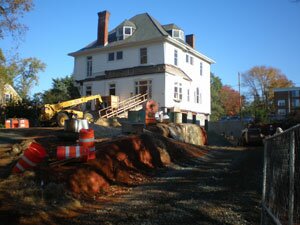ON ARCHITECTURE- A gentle tap: 8-inch sapling replaces old beech
Q: What's the cost of violating a special use permit in the City of Charlottesville?
A: $200.
On November 14, what began as an effort to hold developer David Turner accountable for cutting down a 148-year-old beech tree at 3 University Circle in violation of both his special use permit and his site plan (with talk of possible criminal charges) ended with a slap on the wrist. Or, as Planning Commission member Cheri Lewis puts it, "a pat, really."
The Institute for Advanced Studies in Culture, a UVA interdisciplinary research center, is privately funding the proposed Watson Manor project, which calls for restoring the original 1883 house and creating 8,000 square feet of new construction and 15 below-ground parking spaces. The group was fined $100 for violating the special use permit, and another $100 for violating the site plan– and was then allowed to move forward with the project.
According to Charlottesville neighborhood development chief Jim Tolbert, the site plan will also be revised to include improved landscaping and a new 8" beech to replace the old one.
For those who don't know (perhaps someone living in a tree?), the City issued a stop-work order on the project in August after Turner felled the tree, and angry Planning Commission members lambasted the developer in these pages, calling what he did a "criminal act" and demanding that harsh penalties be enforced.
"This is the most egregious violation of a special use permit I've ever seen," Commission member Jon Fink said at the time. "We're going to suggest that the special use permit get pulled, even if it kills the project."
"They willfully disregarded the instructions in the special use permit," declared former commission member Karen Firehock. "I'm sorry they didn't take us seriously and decided to make a mockery of the city. We really need to come down hard on this, and we intend to."
In part, Commission members were angered by the way Turner's actions seemed to undermine their authority.
"There is no greater power we wield than the special use permit," said Lewis. "We're already allowing exceptions to the existing code. If we permit this applicant to do this, we'll set a precedent where applicants won't take us seriously."
Turner proceeded to defend his actions, even hiring attorney Fred Payne, who at an October hearing before the Board of Zoning Appeals (BZA) claimed that "not only was there a reasonable effort to save the tree, but an extraordinary effort"– although scant evidence of the "extraordinary effort" was presented. Payne also claimed that Tolbert didn't actually have the authority to stop the project, a claim that then assistant city attorney Lisa Kelley vigorously disputed.
"I will not allow them to insist that there's a site plan issue," said Kelley. "The tree was not in danger of falling when they decided to cut it down. They did this because they didn't want to deal with the bureaucracy."
At the BZA hearing, Turner's defense amounted to a presentation that might have been more successful had it been presented to the Planning Commission before he cut down the tree, as there were legitimate issues with the tree that needed to be addressed. Unfortunately, any mitigating issue was a moot point. As BZA chair and former planning commission member Kevin O'Halloran put it, "Some on the Commission may have been sympathetic to the problem, but we never got the chance."
In the end, however, all the outrage over the loss of the tree seems to have dissipated, as the city attorney's office decided against filing criminal charges, Tolbert and the Planning Commission opted to allow the project to continue, and the neighborhood seems satisfied with the concessions the developer made– including a monetary gift.
At the November 14 Planning Commission meeting, Institute co-director Joseph Davis prostrated himself before board members in an attempt to salvage the project.
"We did not respect the process, we did not respect the work of the Commission," said Davis, who took over as project spokesperson after Turner resigned when his attempt to reverse the stop-work order failed at the BZA hearing. "It was foolhardy considering our immense stake in that property... the faculty of the institute is ashamed to be in the position that we're in tonight."
Apparently, Davis also successfully mollified angry University Circle residents by offering the neighborhood $5,000 for the harm the project had caused, an arrangement that Tolbert was quick to distance the City from. "That was a deal between the developer and the neighborhood," he says.
For some, this might appear to be sending the wrong message. Just pay off the neighbors, and your zoning violation goes away. For others, it seemed to be making the best of a bad situation. After all, there was no bringing the treasured beech back to life, and what would be the value of halting a project that the Planning Commission highly favored?
"In over 30 years, I've never seen anything like this," says Tolbert. "It was definitely a series of unfortunate events."
Of course, the last chapter of the story has yet to be written, as final approval for the compromise must be rubber-stamped by City Council.
"No one had a doubt they weren't going to save that tree," says Commissioner Lewis, clearly unsatisfied but resigned to the compromise to save the project. "It was a gut feeling."

Lost cause: In a November 14 Planning Commission compromise, an 8-inch replacement beech tree will take the place of an 148-year-old, 48-inch beech that gave its life for Watson Manor parking.
PHOTO BY DAVE MCNAIR